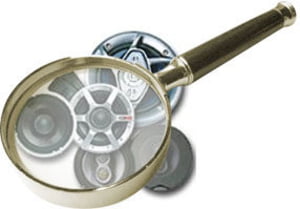3. Technical Data
Power
Generally, when comparing the load capacities of loudspeakers, only one measurement counts - Root Mean Square, or RMS. It is the measure of the speakers capacity to handle sound across the entire frequency range over a long period of time. Beware of figures expressed as maximums - they may be higher than the RMS figure, but operating at maximum capacity is not sustainable and will quickly destroy your speaker.
The higher the RMS value, the greater the load capacity of the speaker. It is usually expressed in Watts (W) - 100W RMS, 500W RMS and so on. Note that the power output of your amplifier in RMS terms should generally be greater than the speakers, taking into account to the impedance of each device. See our PA Amplifier Online Advisor for more information on this.
Transmission range
This is an important measure for musicians in particular, because it indicates the most suitable use for a speaker. Is it good for high, mid, or low-frequency sound? Is it suitable for bass (35 - 3,000Hz), guitar (75 - 7,000Hz) or vocals (80 - 16,000Hz)?
Most people can hear sound in the range between 20Hz and 20,000Hz (Hz = cycles per second). The ideal loudspeaker would be able to transmit effectively across the entire frequency range, although in practice this is virtually impossible.
So the key question is whether or not the loudspeaker can transmit consistently and with good quality within its ideal frequency range. This is known as linear transmission.
Linear transmission is measured as the difference between the input frequency levels and the output frequency levels. It is usually shown as a curve, giving a good indication of the range of frequencies for which the speaker performs best.
The industry uses frequencies separated by a musical third, and the levels are expressed in decibels (dB). Frequency response diagrams are pretty easy to read, in that a positive or negative curve shows which frequencies are transmitted or absorbed by the speaker being measured. A measure of zero indicates a perfect frequency response but dont expect to find it anywhere soon!
A loudspeakers frequency response is strongly affected by the physical construction of the whole device. By contrast, a mixing desk should be able to produce a zero curve because it is simply transmitting electronic signals, whereas microphones will often have the lower ranges raised artificially to produce more power.
Typically, if a frequency response is shown as 40 - 20,000Hz, +/-3dB, you can assume that the bass frequencies were raised at around the +3dB level, and that the higher frequencies were dampened at around -3dB. The usual warning about manufacturer data always applies - they will tend to use the figures that flatter their equipment, though most reputable companies will show fairly accurate frequency response data and RMS values.
Sound pressure
Sound pressure means volume - the higher the pressure of the sound wave striking your ears, the louder it sounds. Its measured, perhaps appropriately, in Pa (short for Pascals in this case - strength per unit area).
In fact, humans have a fairly limited audible range, from around 100Pa (the pain threshold for most of us) to about 20uPa. The ear detects these as logarithmic values, measured in deciBels. Zero dB roughly equates to 20uPa, and it usually starts to hurt for us at around 130dB. We filter out most high and low frequencies, though there are those who believe we respond to them at a subconscious level. When considering speakers, the sound pressure level (SPL) is usually shown in decibels. For example a speaker may be shown as 400W RMS, 118dB SPL.
As with other data, manufacturer information about the sound pressure capabilities of their speakers cannot always be compared reliably. Its not that the manufacturers are dishonest - simply that there are many different ways of measuring sound pressure. What you are looking for is an indication of how much of the signal received is converted faithfully to moving air. The higher the number, the greater the efficiency and/or sound pressure produced by the speaker.
If, for example, you compare two speakers that have a difference of 3dB in their sound pressure ratings, then you can assume that you will need roughly twice the power to achieve the same volume from the lower rated, and therefore less efficient.
Impulse response
This is another indication of the speakers ability to transmit a true sound in real time. You need an oscilloscope to measure it, so in truth your best measurement system is your ears. Just how good does it sound at the kind of volumes you will need?



